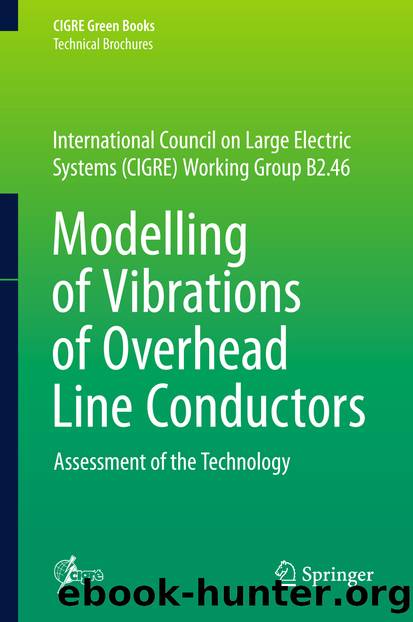Modelling of Vibrations of Overhead Line Conductors by Giorgio Diana

Author:Giorgio Diana
Language: eng
Format: epub
Publisher: Springer International Publishing, Cham
Giorgio Diana
Email: [email protected]
3.1 Introduction
The first two chapters cover the modelling of aeolian vibration of an undamped single conductor and of a single conductor plus one damper. This chapter defines the expected vibration level and assesses the uncertainties associated with the present technology based on the energy balance principle (EBP) and a shaker-based approach. It has been shown that analytical methods based on the EBP and a shaker-based technology can provide a useful design tool for damping systems that protect a single conductor against aeolian vibration.
The purpose of the present chapter is to evaluate the effectiveness of these methods for the design and/or verification of the damping system of long, single conductor spans strung at relatively high tensile load, such as crossings, which need more than one damper per span extremity to be effectively damped against aeolian vibration.
As in the first two chapters, this chapter is based on an analysis of the available technology and on the results of two benchmarks: an analytical–analytical benchmark and analytical–experimental one. The comparison between the analytical results produced by the different available models and the experimental one will help to understand the limitations and the usefulness of the approach.
Some difficulty in finding the data for the analytical–experimental benchmark has been experienced by the WG members and consequently, the specific case of the Messina crossing in Italy was chosen but this does not limit the validity of the assessment.
The application of the EBP technology is more critical for long spans than for normal length spans discussed in the two previous chapters. The EBP in the previous chapters is based on a constant mean wind speed along the entire span but the longer the span length, the more unrealistic it would be to have a constant mean wind along the entire span, especially at the low wind speeds required to produce aeolian vibration. The tensile load variation along the span also becomes significant for large sags and it affects the conductor vibration wavelength.
It must be pointed out that EBP-based methods do not simulate the full complexity of the problem. More sophisticated methods (Rawlins 2000; Giorgio et al. 2009, 2010) can be used to account for the effect of the mean wind speed variation in time and space and wind turbulence, but these are still at a research stage and are not within the scope of this work.
However, the use of the EBP approach, i.e. the assumption of a constant wind speed along the span, for long span applications should guarantee predicted vibration amplitudes higher than those that occur in reality, therefore producing conservative damping system designs.
Outline of the technology
Download
This site does not store any files on its server. We only index and link to content provided by other sites. Please contact the content providers to delete copyright contents if any and email us, we'll remove relevant links or contents immediately.
| Automotive | Engineering |
| Transportation |
Whiskies Galore by Ian Buxton(41533)
Introduction to Aircraft Design (Cambridge Aerospace Series) by John P. Fielding(32890)
Small Unmanned Fixed-wing Aircraft Design by Andrew J. Keane Andras Sobester James P. Scanlan & András Sóbester & James P. Scanlan(32574)
Craft Beer for the Homebrewer by Michael Agnew(17935)
Turbulence by E. J. Noyes(7702)
The Complete Stick Figure Physics Tutorials by Allen Sarah(7143)
Kaplan MCAT General Chemistry Review by Kaplan(6597)
The Thirst by Nesbo Jo(6439)
Bad Blood by John Carreyrou(6278)
Modelling of Convective Heat and Mass Transfer in Rotating Flows by Igor V. Shevchuk(6225)
Learning SQL by Alan Beaulieu(6037)
Weapons of Math Destruction by Cathy O'Neil(5832)
Man-made Catastrophes and Risk Information Concealment by Dmitry Chernov & Didier Sornette(5650)
Digital Minimalism by Cal Newport;(5392)
Life 3.0: Being Human in the Age of Artificial Intelligence by Tegmark Max(5189)
iGen by Jean M. Twenge(5163)
Secrets of Antigravity Propulsion: Tesla, UFOs, and Classified Aerospace Technology by Ph.D. Paul A. Laviolette(4994)
Design of Trajectory Optimization Approach for Space Maneuver Vehicle Skip Entry Problems by Runqi Chai & Al Savvaris & Antonios Tsourdos & Senchun Chai(4843)
Electronic Devices & Circuits by Jacob Millman & Christos C. Halkias(4749)
